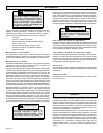
Page 2
IMPORTANT SAFETY INSTRUCTIONS
SAVE THESE INSTRUCTIONS
READ AND SAVE ALL INSTRUCTIONS FOR
FUTURE REFERENCE.
FUNCTIONAL DESCRIPTION
1. Red control light
Light off indicates: Charger is ready for operation
Battery pack is charged
Maintenance charging
Continuous light indicates: Charging (Fast, if battery
temperature is between 41°F
(5°C) and 113°F (45°C)
Flashing light indicates: Battery pack is too hot or too cold
(Charging will begin automatically
when battery reaches correct
charging temperature)
2. Instruction label
3. Electrical contacts
4. Battery pack port
5. Vents
6. Nameplate (on back of charger)
7. Key hole slots: Mounts charger vertically
(on bottom of charger)
8. Cord wrap: Stores excess cord
(on bottom of charger)
1. CAUTION! To reduce the risk of injury, charge only
MILWAUKEE 9.6, 12, 14.4 and 18 Volt Power Plus Battery packs in
this charger. Other types of batteries may explode, causing personal
injury or damage.
2. AVOID DANGEROUS ENVIRONMENTS. Do not use charger in rain,
snow, damp or wet locations. Do not use battery pack or charger in
the presence of explosive atmospheres (gaseous fumes, dust or
flammable materials) because sparks may be generated when insert-
ing or removing battery pack, possibly causing fire.
3. CHARGE IN A WELL VENTILATED AREA. Do not block charger
vents. Keep them clear to allow proper ventilation. Do not allow
smoking or open flames near a charging battery pack. Vented gases
may explode.
4. MAINTAIN CHARGER CORD. When unplugging charger, pull plug
rather than cord to reduce the risk of damage to the electrical plug and
cord. Never carry charger by its cord. Keep cord from heat, oil and
sharp edges. Make sure cord will not be stepped on, tripped over or
subjected to damage or stress. Do not use charger with damaged
cord or plug. Have a damaged cord replaced immediately with identi-
cal replacement parts (see Maintenance).
5. DO NOT USE CHARGER OR BATTERY PACK IF it has received a
sharp blow, been dropped or damaged in any way. Do not disas-
semble. Incorrect reassembly may result in the risk of electric shock,
fire or exposure to battery fluids. If it is damaged, take it to a
MILWAUKEE service facility.
6. CHARGER IS RATED FOR 120 VOLT AC ONLY. Charger must be
plugged into an appropriate receptacle.
7. USE ONLY RECOMMENDED ATTACHMENTS. Use of an attachment
not recommended or sold by the battery charger manufacturer may
result in a risk of fire, electric shock or personal injury.
8. DO NOT USE AN EXTENSION CORD UNLESS IT IS ABSOLUTELY
NECESSARY. Using the wrong, damaged or improperly wired exten-
This manual contains important safety and operating instructions for battery chargers. Before using the battery charger, read this manual as well as any
labels on the charger, battery pack and tool.
sion cord could result in the risk of fire and electrical shock. If an
extension cord must be used, plug the charger into a properly wired
16 gauge or larger extension cord with pins that are the same num-
ber, size and shape as the pins on the charger. Make sure that the
extension cord is in good electrical condition.
9. DO NOT BURN, MUTILATE OR DISASSEMBLE BATTERY PACK.
The battery pack can explode in a fire. Mutilation may expose battery
fluids, causing burns.
10. BATTERY FLUIDS CAUSE SERIOUS CHEMICAL BURNS. Never al-
low contact with skin or eyes. If a damaged battery pack leaks
battery fluids, use rubber or neoprene gloves to dispose of it. If skin
is exposed to battery fluids, wash with soap and water and rinse
with vinegar. Remove and dispose of contaminated clothing. If eyes
are affected, immediately flush with water for 15 minutes and seek
medical attention.
11. DO NOT SHORT CIRCUIT. A battery pack will short circuit if a metal
object makes a connection between the positive and negative con-
tacts on the battery pack. Do not place a battery pack near anything
that may cause a short circuit, such as coins or keys in your pocket.
A short circuited battery pack may cause fire and personal injury.
12. UNPLUG CHARGER when not in use.
13. TO REDUCE THE RISK OF ELECTRIC SHOCK, always unplug charger
before cleaning or maintenance, turning off controls will not reduce
this risk. Use a Ground Fault Circuit Interrupter (GFCI) to reduce shock
hazards.
14. STORE YOUR BATTERY PACK AND CHARGER in a cool, dry place.
Do not store battery pack where temperatures may exceed 120°F
(50°C) such as in a vehicle or metal building during the summer. Charger
will charge the battery at the most rapid rate when the temperature is
between 41°F (5°C) and 113°F (45°C). When the battery temperature
is outside that range, charging will take longer.
3
4
2
6
8
7
5
1














